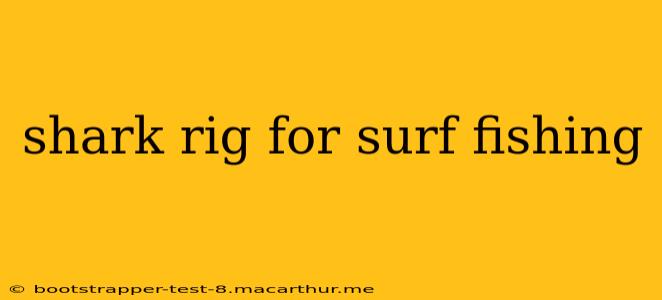Surf fishing for sharks is an exhilarating experience, demanding specialized gear and techniques. A properly rigged shark rig is crucial for landing these powerful predators. This guide delves into the essential components, techniques, and safety precautions for successful shark fishing in the surf. We'll cover everything from selecting the right rod and reel to choosing the ideal bait and deploying your rig safely.
What is a Shark Rig?
A shark rig for surf fishing is a specialized fishing setup designed to withstand the immense power and sharp teeth of sharks. Unlike rigs for smaller fish, it emphasizes strength, durability, and the ability to handle heavy drag. Key features include:
- Heavy-duty rod: A sturdy surf rod rated for at least 50-80 pounds test line is essential. Longer rods (10-12 feet) provide better casting distance and leverage for fighting large sharks.
- Powerful reel: A heavy-duty spinning or conventional reel with a high gear ratio and substantial drag capacity is necessary to handle the power of a hooked shark.
- Strong line: Braided fishing line with a high breaking strength (80-130 pounds test) is recommended. Braided line's strength-to-diameter ratio is crucial for long casts and fighting big fish.
- Heavy-duty swivels: These prevent line twist and allow for free movement of the bait. Use swivels with a breaking strength significantly higher than your line.
- Strong hooks: Circle hooks are preferred for shark fishing due to their reduced risk of deep hooking. Select heavy-duty circle hooks (8/0 to 12/0) appropriate for the size of shark you target.
- Heavy leader: Use a strong, abrasion-resistant leader (e.g., wire or fluorocarbon) to protect against shark teeth. The leader should be at least 50-100 pounds test and several feet long.
- Appropriate weight: Use heavy weights (bank sinkers or pyramid weights) sufficient to cast your bait far enough into the surf zone and hold it in place. Weight selection depends on the surf conditions and casting distance.
What kind of bait is best for shark fishing?
The best bait for shark fishing depends on the species you are targeting and the location. However, some popular choices include:
- Bonito: A highly effective bait, particularly for larger sharks.
- Mackerel: Another excellent choice, readily available in many coastal areas.
- Mullet: A readily available and effective bait, especially for smaller shark species.
- Squid: Often effective, particularly when cut into strips.
- Tuna: Effective for attracting larger sharks but can be expensive.
Remember to always check local regulations regarding legal bait and size limits for shark species.
What are the best locations for surf fishing for sharks?
The best locations for surf fishing for sharks vary depending on the species and geographic location. However, areas known for shark activity, typically with deep water close to shore, are ideal. Look for spots with rocky outcrops, channels, or areas with significant tidal currents. Local fishing guides and experienced anglers are invaluable sources of information.
How to rig a shark fishing setup?
The process involves connecting all the components mentioned above in a way that's both effective and safe. This typically involves attaching your main line to a heavy-duty swivel, followed by your leader, then attaching your hook to the end of the leader. The weight should be placed several feet above the hook to aid in casting and presentation. The exact setup can be customized based on local conditions and preferred techniques. Consider using a heavy-duty snap swivel to attach the leader to the main line for easy bait changes.
What safety precautions should I take when surf fishing for sharks?
Shark fishing demands careful attention to safety. Key safety precautions include:
- Never fish alone. Always have a fishing buddy nearby for assistance and safety.
- Inform someone of your plans. Let someone know where you're fishing and when you expect to return.
- Be aware of your surroundings. Pay attention to the surf conditions and potential hazards like strong currents and rocks.
- Use appropriate safety gear. Wear appropriate footwear to avoid injury on sharp rocks and sturdy gloves for protection from bites.
- Be prepared for a large fight. A large shark can put up a significant fight, so ensure you have the appropriate equipment and know how to handle the situation safely.
- Know the local shark species and regulations. This is crucial for responsible and safe fishing.
What is the best time to go surf fishing for sharks?
The best time for surf fishing for sharks depends on several factors, including the species you’re targeting and the local tides and currents. Generally, early mornings and evenings often yield better results. Check the tides to understand tidal flows in relation to the surf and the feeding patterns of the targeted sharks. Consult tide charts and consider the time of year; some species are more active during certain seasons.
Remember, responsible and ethical fishing practices are vital. Always respect the environment and adhere to all local fishing regulations. By following these guidelines and prioritizing safety, you can maximize your chances of a successful and memorable shark fishing experience in the surf.
